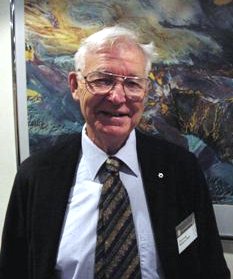 Doyen of palaeomagnetism who discovered some of the best early geophysical evidence for continental drift which convinced many sceptics.
Doyen of palaeomagnetism who discovered some of the best early geophysical evidence for continental drift which convinced many sceptics.
Ted Irving was the doyen of land-based palaeomagnetism throughout the second half of the twentieth century. By the early 1960s he, more than anyone else, convinced sceptics that continental drift had occurred. His postgraduate work in Cambridge 1951-54 on the “Torridonian” of NW Scotland was a “world first” in at least two respects: the first thorough study of Precambrian rocks to establish consistent palaeomagnetic directions strongly divergent from the present geomagnetic field, and including a coherent stratigraphy of polarity reversals.
He also found a previously unrecognised discontinuity in the lower part of the sequence which was recognised geologically many years later as marking a major unconformity of the Torridon Group on the much older Stoer Group beneath. As he wrote recently “In 1951 it was not known if Earth had a magnetic field as far back as the Precambrian or even whether rocks could retain a memory of the geomagnetic field for that long. Demagnetisation techniques had not yet been developed, we had only field and consistency tests.” Nor, at the time, was the reality of geomagnetic polarity reversals proven or even widely accepted. The results were published in a landmark issue of Phil Trans Roy Soc A (1957).
Astonishingly, Irving’s Ph.D. thesis was failed. Several reasons have been speculated upon. It is widely reckoned that his supervisor, Keith Runcorn, and the internal examiner and head of department (Ben Browne) were in conflict. The unorthodox evidence of the large time-gap in the Torridonian sequence may have been unacceptable to the external examiner, John Hemingway, whose geological fiefdom had been intruded upon. In later years Irving would simply say that his thesis had been skimpy. However by then he had been awarded an ScD by Cambridge (1965), elected Fellow of the Royal Society (1979) and the equally valued Fellowship of the American Geophysical Union (1976).
From Cambridge Irving was recruited by J C Jaeger to the fledgling Australian National University’s Department of Geophysics where he swiftly determined an apparent polar wander path from Australian Phanerozoic rocks which diverged wildly from both the British path and a path from North America derived in the meantime by Runcorn. This result, published in Geophysical Journal of the Royal Astronomical Society was, for many including Sir Edward Bullard, the decisive indication of the reality of continental drift. It would be a full decade before spectacular evidence from the oceanic realm, of sea-floor spreading and transform fault motions, clinched the argument. In the meantime he brought the comparison of geological and palaeomagnetic data to the forefront of the debate in a series of papers beginning with “Palaeomagnetic and palaeoclimatological aspects of polar wandering” (1956) which also reported the first data (seven samples) from the Deccan Traps which pointed to the enormous Cenozoic northward drift of India.
After the plate tectonics revolution Irving made major contributions to the evolution of the Western Cordillera, demonstrating in nearly 30 papers the far travelled origins of tectonic terranes within it, as well as 30+ works adding to understanding of the Canadian Shield and the Precambrian geomagnetic field, and participating in the seemingly never-ending controversies about the configuration of Pangaea.
Ted Irving was born in Colne, Lancashire on 27 May 1927, educated at Colne Grammar School and, after military service, graduated in geology from Cambridge in 1951. He married Sheila (nee Irwin), daughter of the Canadian High Commissioner to Australia, in 1957. They had two daughters and then identical twin boys who arrived at the same time as Ted was completing his monumentally comprehensive book “Paleomagnetism and its Application to Geological and Geophysical Problems” (Wiley, 1964) which still makes salutary reading today.
At ANU Irving rose to Senior Fellow before moving to the Dominion Observatory (later Earth Physics Branch of the Department of Energy Mines and Resources) in Ottawa in 1964. In 1966, on the inspiration of W Q Kennedy, the University of Leeds redesignated its Geology Department to become the first Earth Sciences Department in the UK. Irving was appointed the first Professor of Geophysics. For Ted personally, it was not a success. For Leeds it was a lesson that broadening a Geology Department involved more than a change of name. Ted returned to Canada to the Dominion Observatory and stayed with that organisation for the rest of his career and through its several administrative restructurings, moving to the Pacific Geoscience Centre at Sidney, British Columbia in 1981.
Irving was made a Fellow of the Royal Society of Canada (1973), Foreign Associate of the U.S. National Academy of Sciences (1998), and member of the Order of Canada (2002). He was adjunct professor at Carleton University and University of Victoria, being awarded honorary doctorates from both, and also from Memorial University of Newfoundland. He received the Logan Medal (Geological Association of Canada), Bucher Medal (American Geophysical Union), Wilson Medal (Canadian Geophysical Union), Gondwanaland Gold Medal (Mining, Geological, and Metallurgical Society of India), Wegener Medal (European Geophysical Union), Day Medal (Geological Society of America) and, in 2005, the Wollaston Medal of the Geological Society . At a dinner in the Council Room following that award, Ted seemed quite surprised at the high regard and affection in which he was so widely held.
Ted Irving died of cancer in Saanichton, British Columbia, Canada, on February 25, 2014.
Written by Jim Briden
References
- Stewart (1966)
- Creer and Irving (2012).
- Yet the essential correctness of the original conclusions has been vindicated in a modern study (Darabi and Piper, 2004)
- The citation and response make good reading.
Ted Irving at a dinner held in his honour in 2005, when he received his Wollaston Medal. Photo: Ted Nield
